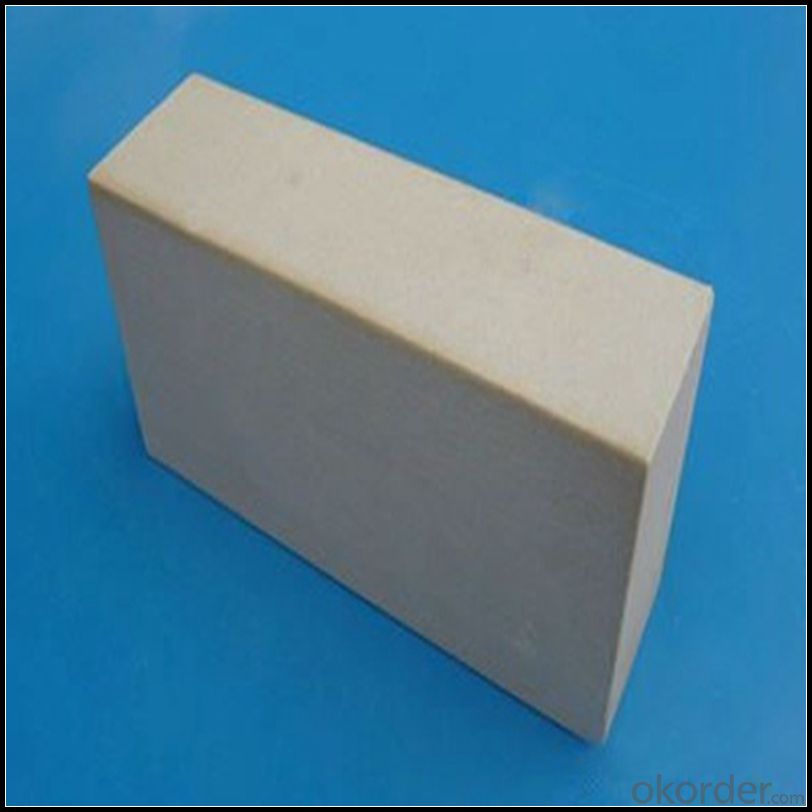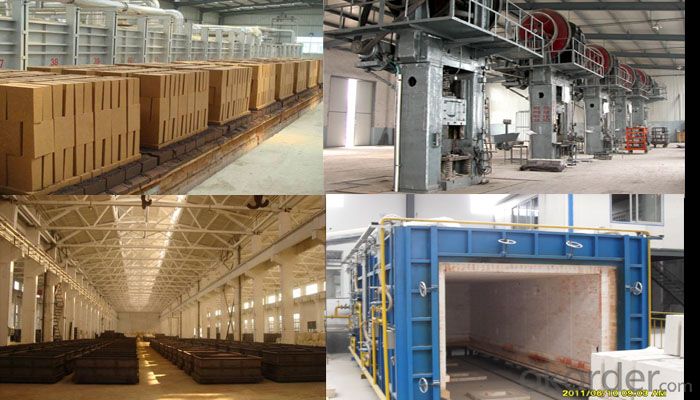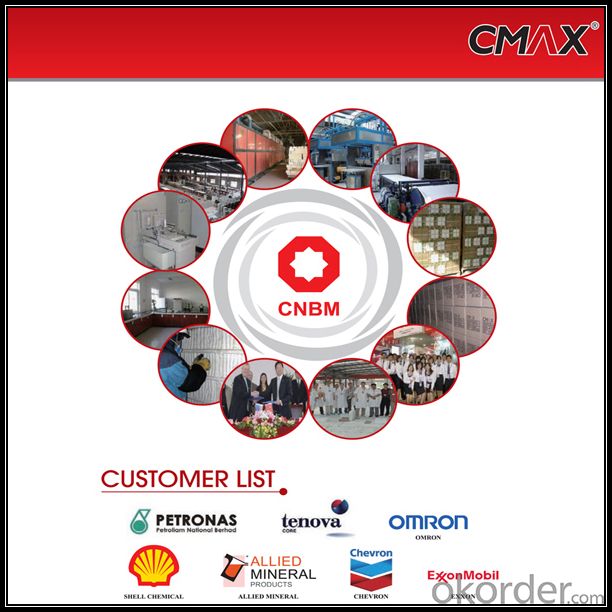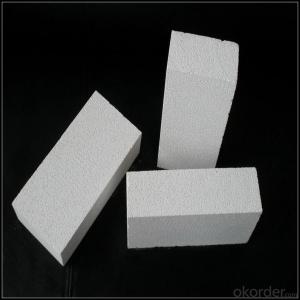Standard Size Refractory Bricks
- Loading Port:
- China main port
- Payment Terms:
- TT OR LC
- Min Order Qty:
- 0.01
- Supply Capability:
- 1800 m.t/month
OKorder Service Pledge
OKorder Financial Service
You Might Also Like
Refractory Brick
CMAX firebricks are classified under temperature between 1300℃ to 1700℃, manufactured from high purity alumina clay by mixing, press-forming, drying, sintering and machining. Bricks contain carefully-graded organic fillers which are burned out during sintering to give a uniform controllable pore structure. This technique makes product feature low thermal conductivity and excellent heat insulation

Features
1.low porosity
2.high compressive strength.
3.all size you need
4.best price with high quality
5.long using time
Application
1.Building material industry,kiln,heating equipment and the inwall of high—temperature pipe line
2.Chemical industrial high temperature of reaction equipment inwall
3.Power plant ,gas turbine engine and heat insulation of unclear power
4.The fire proof of high—rise building
5.Furnace door of kiln
6.High-temperature filter material
Data Sheet
Classification Temperature (℉/℃) | 3000/1650 |
Bulk Density (g/cm3 ) | ≤1.0 |
Thermal Conductivity | |
800℃, W/m.K | ≤0.39 |
1000℃, W/m.K | ≤0.43 |
1200℃, W/m.K | ≤0.48 |
Reheating Linear Change (%) | 1550℃×12h |
≤0.9 | |
Chemical Composition (%) | |
Al2O3 | ≥75 |
Fe2O3 | ≤0.5 |
Packaging & Shipping
Packaging Details:Be packed in fumigated wooden pallets
Delivery Detail: 30 days after order

Our Services
Optimum solution and product supply of refractories for high temperature industries, such as iron steel, non-ferrous, petrochemical and building materials.
Engineering design, contract and consult for refractories, and civil architecture design.
Research, development, manufacture and sale of superhard materials.
R&D, manufacture and sale of special packing materials for export.
Inspection, supervision and arbitration of refractories.
Consultation and services in refractories information.
Training and cultivation of high-level talents in refractories profession
Sales Network

Company Information
CNBM (China National Building Material) Group is the largest comprehensive building materials group in China that in integrate scientific research, manufacturing and logistics into one entity. The largest building materials and equipment specialists in China. Upon State Council approval, today CNBM owned more than 300 subordinate manufacturing factories and servicing companies. There are 6 fully owned public listed companies and 11 partially owned with substantial shares public listed companies. In many of these fields, CNBM is playing the leading role in the building industry in the country.


FAQ
1. Which products do you have?
We have all kinds of refractory brick, castable, mortar, cement, ceramic fiber products, etc.
Or you could browse our products to choose what you need.
2. Can you give me a brief introduction of the application of your products?
We are mainly specializing in the refractory materials in iron and steel, cement, glass, ceramics, petrochemical, electric power Industry, etc.
3. If I need your offer, what information do you need?
In order to choose suitable products, it will be appreciated to provide us the information, such us specification, technical data, order quantity, products application etc. If any question, please contact us freely.
- Q:Can insulating fire bricks be used in high-velocity gas flow applications?
- Insulating fire bricks are suitable for high-velocity gas flow applications due to their excellent thermal insulation properties, low thermal conductivity, and high resistance to temperature fluctuations. These characteristics make them appropriate for use in various high-temperature environments, including those with high-velocity gas flow. When subjected to high-velocity gas flow, insulating fire bricks maintain their structural integrity and insulation properties, effectively providing thermal insulation and protection. They find frequent application in kilns, furnaces, boilers, and other industrial equipment where high-velocity gas flow is present. However, it is essential to consider the specific requirements and characteristics of the gas flow in the given application. Parameters such as temperature, pressure, and chemical composition of the gas must be considered to ensure the compatibility and endurance of the insulating fire bricks. In conclusion, insulating fire bricks can be utilized in high-velocity gas flow applications due to their thermal insulation properties and resistance to temperature fluctuations. Nevertheless, it is crucial to carefully evaluate the specific requirements and characteristics of the gas flow to guarantee proper compatibility and performance.
- Q:What are the different types of insulating fire bricks available?
- There are various types of insulating fire bricks available, each possessing unique characteristics and applications. Some of the most common types are: 1. Lightweight Insulating Fire Bricks (IFBs): These bricks consist of lightweight materials, such as expanded clay, perlite, or vermiculite, blended with a binder to create a porous structure. They offer exceptional insulation properties and find wide usage in applications where maintaining high temperatures is crucial, like in kilns or furnaces. 2. Mullite Insulating Fire Bricks: Mullite bricks are composed of a combination of alumina and silica, resulting in a material resistant to high temperatures. These bricks exhibit excellent thermal shock resistance and are frequently utilized in applications involving rapid heating and cooling cycles, such as in glass manufacturing or incinerators. 3. Alumina Insulating Fire Bricks: As the name suggests, these bricks are primarily made from alumina, which is highly resistant to high temperatures. They possess excellent thermal conductivity and are commonly employed in industries where maintaining high temperatures is essential, such as the iron and steel industry or ceramics production. 4. Silica Insulating Fire Bricks: Silica bricks are mainly composed of silica, a heat-resistant material. They exhibit exceptional thermal insulation properties and are commonly used in applications where maintaining high temperatures is necessary, like in the construction of kilns or furnaces. 5. Calcium Silicate Insulating Fire Bricks: These bricks are created by combining calcium silicate with other insulating materials. They possess excellent thermal insulation properties and are often employed in industries where maintaining high temperatures is crucial, such as the petrochemical industry or power plants. Ultimately, the choice of insulating fire brick depends on the specific requirements of the application, including temperature resistance, thermal conductivity, and thermal shock resistance. It is vital to select the appropriate type of insulating fire brick to ensure optimal performance and safety.
- Q:Are insulating fire bricks resistant to high-velocity gases?
- Yes, insulating fire bricks are resistant to high-velocity gases. These bricks are specifically designed to withstand extreme temperatures and are often used in applications where high-velocity gases are present, such as in furnaces and kilns. Their dense and non-porous structure helps to prevent gas penetration, making them an ideal choice for insulation in such environments.
- Q:Are insulating fire bricks resistant to hydrogen sulfide?
- Yes, insulating fire bricks are generally resistant to hydrogen sulfide due to their high melting point and chemical stability.
- Q:Can insulating fire bricks be used for insulation in gas furnaces?
- Yes, insulating fire bricks can be used for insulation in gas furnaces. Insulating fire bricks are made from lightweight materials such as clay and other minerals, which have excellent insulating properties. They are designed to withstand high temperatures and are commonly used in industrial applications, including gas furnaces. These bricks help to minimize heat loss, improve energy efficiency, and maintain high temperatures within the furnace. Additionally, insulating fire bricks are resistant to thermal shock and can withstand the corrosive effects of gases and chemicals present in gas furnaces. Therefore, they are a suitable choice for insulation in gas furnaces.
- Q:How do insulating fire bricks handle moisture?
- Insulating fire bricks have been specifically designed to effectively manage moisture. Composed of top-quality refractory materials, these bricks possess a minimal level of porosity. This characteristic plays a key role in preventing the infiltration of moisture into the bricks. Moreover, insulating fire bricks possess a compact structure and are often covered with a safeguarding sealant or glaze, which further diminishes their vulnerability to moisture. This combination of low porosity and protective coating confers upon the bricks the ability to withstand the detrimental impacts of moisture, including cracking, deterioration, or compromised insulating capabilities. Ultimately, insulating fire bricks have been meticulously engineered to skillfully handle moisture, guaranteeing their resilience and optimal performance in a diverse range of high-temperature applications.
- Q:What is the recommended curing time for insulating fire bricks?
- The recommended curing time for insulating fire bricks can vary depending on several factors such as the type of brick, the specific application, and the manufacturer's instructions. However, in general, it is advisable to allow a curing time of at least 24 to 48 hours for insulating fire bricks. This allows the bricks to dry and harden properly, ensuring their stability and performance in high-temperature environments. It is important to follow the manufacturer's guidelines and recommendations for curing time to achieve the best results. Additionally, factors such as humidity, temperature, and ventilation can also influence the curing process, so it is important to consider these factors when determining the appropriate curing time for insulating fire bricks.
- Q:What is the function of insulating bricks? Where can I use it?
- Low thermal conductivity, high strength, strong durability, simple construction, light weight, easy loading and unloading, economic, green, environmental protection, sound insulation, fire protection and so on.Thermal insulation brick is a new type of energy-saving building insulation technology with inorganic composite material as the main material. It is an ideal technology to replace the traditional wall insulation. The insulation brick integrates the excellent heat preservation effect into the wall while building the wall.
- Q:Can insulating fire bricks be used in the construction of incinerators?
- Yes, insulating fire bricks can be used in the construction of incinerators. Insulating fire bricks have excellent thermal insulation properties, which are crucial in maintaining high temperatures and improving energy efficiency within the incinerator. These bricks have a low thermal conductivity, allowing them to effectively retain heat and minimize heat loss. Additionally, insulating fire bricks are resistant to high temperatures and can withstand the intense heat generated by the incineration process. This makes them a suitable choice for lining the walls, floors, and roofs of incinerator chambers, helping to ensure the efficient and safe operation of the incinerator.
- Q:How do insulating fire bricks affect the overall noise insulation of a building?
- Insulating fire bricks can significantly enhance the noise insulation of a building. These bricks have excellent sound-absorbing properties due to their high density and ability to dampen sound vibrations. By reducing the transmission of airborne and impact noises, insulating fire bricks help create a quieter and more peaceful indoor environment.
1. Manufacturer Overview |
|
|---|---|
| Location | |
| Year Established | |
| Annual Output Value | |
| Main Markets | |
| Company Certifications | |
2. Manufacturer Certificates |
|
|---|---|
| a) Certification Name | |
| Range | |
| Reference | |
| Validity Period | |
3. Manufacturer Capability |
|
|---|---|
| a)Trade Capacity | |
| Nearest Port | |
| Export Percentage | |
| No.of Employees in Trade Department | |
| Language Spoken: | |
| b)Factory Information | |
| Factory Size: | |
| No. of Production Lines | |
| Contract Manufacturing | |
| Product Price Range | |
Send your message to us
Standard Size Refractory Bricks
- Loading Port:
- China main port
- Payment Terms:
- TT OR LC
- Min Order Qty:
- 0.01
- Supply Capability:
- 1800 m.t/month
OKorder Service Pledge
OKorder Financial Service
Similar products
New products
Hot products
Related keywords





























